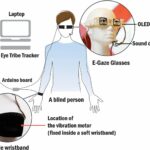Shi Qiu, Jun Hu, Ting Han &Matthias Rauterberg
During the design, it is important to evaluate the user experience of representative users in many human product interactions. But, in some cases, it is difficult or even impossible to recruit representative users because they have disabilities that do not allow them to take part in such investigations. Thus, alternative populations are widely studied. The most common way to replace real blind people is to use sighted but blindfolded users when studying design solutions. To test whether such alternative or proxy users can be used to represent blind people in social interactions, we examined the communication quality of 20 blind-sighted pairs and 20 blindfolded-sighted pairs in two different experiments. A prototype named E-Gaze glasses was evaluated as the testing tool. Results clearly show that the blindfolded participants achieved significantly higher communication quality than the blind participants. In qualitative data analysis, the blindfolded participants also reported their user experience of being blindfolded in conversations. Our qualitative results strengthen the conclusion that blindfolded users’ behaviour is different from real blind users’ behaviour. We recommend that blind users should not be substituted for blindfolded users in human product evaluations when communication quality is measured.
